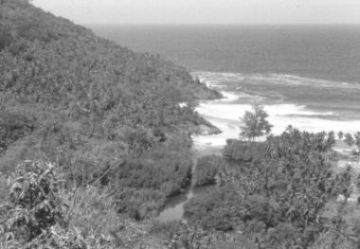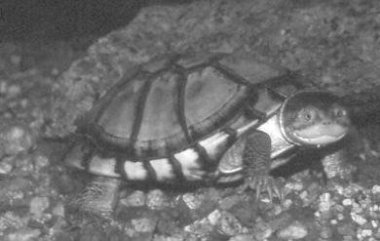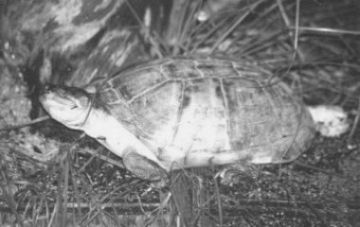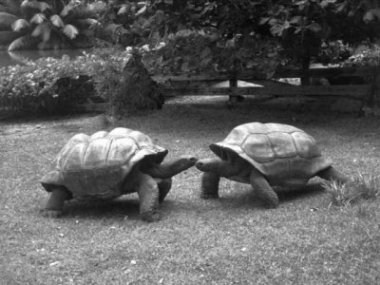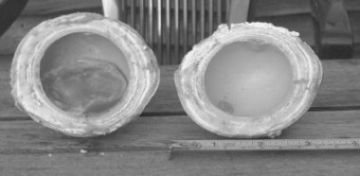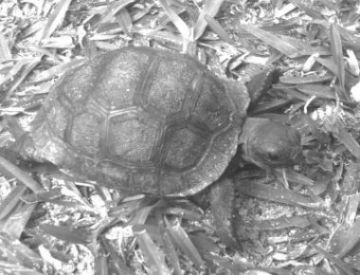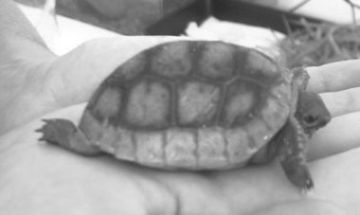Justin Gerlach.
When the first explorers visited Seychelles in the 1700s the islands abounded with Chelonia (Gerlach, 1995). Enormous numbers of sea turtles (both hawksbills Eretmochelys imbricata and green Chelonia mydas) were found nesting or in the shallow coastal waters. Giant tortoises were common in lowland areas of all the islands and presumably terrapins were common in the rivers (but completely overlooked until the late 1800s). 200 years of human habitation has changed the islands and the turtles, tortoises and terrapins have been particularly badly hit by direct consumption, export and habitat loss. In 1992 the Nature Protection Trust of Seychelles was established to conserve the native fauna and flora of the islands. Since its establishment the NPTS has had a strong interest in Chelonia and established the Seychelles Giant Tortoise and Seychelles Terrapin Conservation Projects on Silhouette island in 1997. Here I report on the first five years of these projects (1997-2002).

Map of the Granitic Islands of Seychelles
MARINE TURTLES
NPTS interest in Chelonia started in the trust’s first year with a publicity campaign in favour of a ban on the killing and export of marine turtles. Until this time green turtles were exploited for meat (although under nominal regulations) and hawksbills killed for tortoiseshell for export. In 1992 all killing of turtles was banned and the new regulations enforced. Craftsmen using hawksbill shell were retrained under a World Bank project with the Seychelles government. As a result turtles are no longer exploited in significant numbers (although poaching continues and this may be at fairly high levels on the more rarely visited islands). Turtles remain threatened due primarily to loss of nesting beaches on the larger islands as a result of development. Increases in the number nesting on reserve islands such as Aride (reaching 66 in 2002-3) and Bird island (170 in 2000-1) and conservation managed private islands like Cousine (82 in 2001-2) and Fregate (11 green turtles in 2001-2) (Hill, 2001) may ensure their long-term survival.
Since 1997 the NPTS has monitored the number of turtles nesting on Silhouette (Table 1), largely through information provided by island residents and tourists on the east side of the island. This has recorded small numbers of hawksbill turtles nesting (approximately 20 nests per year) and very rarely green turtles (4 in June 2001). The west of the island is too isolated to allow regular monitoring access. A visit to the largest beach, Grande Barbe, just before the peak of the nesting season in December 2002 recorded 35 recent hawksbill nests. Data from Aride island where monitoring data covers 15 years indicates that one third of the season’s nests would have been laid by this time, giving a crude estimate of 115 nests at Grande Barbe. Turtles are also known to nest at the nearby, largely inaccessible beach of Pointe Etienne.
Two nesting turtles have been recorded with tags on their flippers (as most observers do not look for tags for fear of disturbing the turtle we do not know what proportion of turtles are tagged; the records obtained suggest that at least 5% have tags). No turtles are tagged on Silhouette so these must be turtles tagged on other islands.
Table 1. Records of turtle nests on Silhouette island
| Season | 1998-1999 | 1999–2000 | 2000-2001 | 2001- 2002 | 2002-2003 |
|---|
| Beach |
|---|
| Baie Cipailles | 1 | | 2 | | |
| La Passe | 1 | 2 | 3 | 1 | |
| Anse Lascars (N) | 1 | 1 | 5 | | 6 |
| Anse Lascars (S) | | | 1 | | 2 |
| Anse Patates | 1 | | | 1 | 6 |
| Grande Barbe | | 2 | 1 | 18 | 35 |
| Pointe Etienne | | 1 | | | |
TERRAPINS
Work on terrapins started in 1996 with a research project aimed at determining their status and conservation needs. This project and monitoring carried out since then have determined that the two endemic Seychelles subspecies of black mud turtle Pelusios subniger parietalis and chestnut-bellied mud turtle P. castanoides intergularis are Critically Endangered (Gerlach & Canning, 2001). No evidence of the continued survival of the Seychelles terrapin P. seychellensis could be found. This species is known from only three specimens collected on an unknown island in 1895 and remains an enigma with apparent close relationships to West African terrapins. The 1996 study identified habitat loss and predation as the main causes of the current critically low populations and proposed habitat protection, captive breeding and reintroduction as measures needed for conservation. The field study also provided preliminary ecological data, determining that P. subniger is a marsh inhabiting species whilst P. castanoides is primarily riverine, favouring slow-flowing rivers in coastal woodland.
In 1997 the Seychelles Terrapin Conservation Project was started with the approval of the Seychelles Ministry of Environment whose consent was required as keeping of these terrapins is not permitted by Seychelles law. In July 1997 four captive P. subniger (1 male, 3 females) were acquired from the Anse Forbans marsh where they had been kept in a semi-starved condition, and four P. castanoides (1 male, 3 females) from the Rivière Mare Anglaise, both on Mahé. A further female P. subniger and a male P. castanoides were donated to the project later in the year from an unknown locality on Mahé.
P. subniger
The first remains of eggs were found in the water of the P. subniger enclosure in 1998. Intact eggs were found in the water in January-April 1999; all eggs were laid in the water and varied in weight from 7.0 to 9.0 g. Attempts to incubate these eggs failed due to dehydration in the incubator, with the exception of one egg which was predated by a rat just before it would have hatched. On 22nd July a new pond for P. subniger and two ponds for P. castanoides were completed with funds from the US Ambassador’s Self-Help Fund. The new ponds were made of varnished marine plywood, measuring 1x2m with a water depth of 50cm. Within 24 hours four P. subniger had drowned despite ramps out of the ponds being easily accessible. The surviving P. subniger was removed to a dry enclosure with a shallow bowl of water. The P. subniger pond was part filled with sand to reduce the water depth to 30cm as it appeared that they were unable to reach the surface to breathe whilst sleeping. Five new P. subniger (3 males, 2 females) were collected from a captive group originating from Anse Forbans. Courtship was observed in P. subniger in September; towards the end of the year the pond was only occupied by one female and two males, the others remaining on land. This declined to a single male in the pond by January 2000 when it was concluded that aggression by a dominant male was keeping the other males out of the water. The additional males were removed to a new pond. A clutch of damaged eggs was found in the pond on 22nd December.
A shallow pond was constructed in January 2000 allowing possibly gravid females to be kept in isolation, allowing regular checks for eggs to be made and rescued before they became waterlogged. Ten eggs were laid by the 1997 survivor in January and incubated. The first hatchling was produced on 3rd March after an incubation period of 47 days (29mm long, 5g) (Gerlach, 2001). This hatchling disturbed the only other developing egg which failed to hatch. Two further female P. subniger were added in 2000-2001; one rescued from captivity at Anse Forbans in April 2000, and a long-term captive originally from Fregate island donated in May 2001. Mating was observed in P. subniger on 22nd January 2001. Three clutches of eggs were laid in the water in January-March and 9 eggs hatched by April. For the 2001-2002 season matings were observed in November and December and eggs laid in December (9), January (8) and February (8), hatching in January, February and March. Hatchling weights were 5.0-6.5g. Results of P. subniger breeding are summarised in Tables 2 and 3.
Table 2. Pelusios reproductive data
| Species | Adult weight | Clutch size | Egg weight (g) | Incubation days |
|---|
| (mean±SE) | (range) |
|---|
| P. subniger | 16.6cm (S5) | 8-9 | 8.26±0.79 | 6.8-9.0 | 49-55 |
| 17.4cm (S6) | 8-9 | 8.30±0.45 | 7.9-9.1 | 45-49 |
| 18.0cm (S11) | 9 | 9.12±0.30 | 8.8-9.7 | 47-51* |
| P. castanoides | 20.4cm (C1) | 13 | | 9.2-10.5 | |
| 17.0cm (C4) | 11 | | 6.6-8.4 | |
* 6 eggs at 47 days in 2001, 3 at 51 days in 2002 when lower temperatures occurred by accident
Table 3. Summary of Pelusios breeding results
| Species | Year | 1999-2000 | 2000-1 | 2001-2 | 2002-3 |
|---|
| P. subniger | Eggs | 18 | 23 | 25 | 8 |
| Hatchlings | 1 | 9 | 12 | 6 |
| P. castanoides | Eggs | 0 | 3 | 2 | 24 |
| Hatchlings | 0 | 0 | 0 | 0 |
P. castanoides
In contrast to P. subniger, P. castanoides adapted well to the new ponds. P. castanoides were separated with a male and one or two females in each pond from July 1999, but in the absence of any breeding attempts one male was left in isolation for a month in early 2000 and the largest female introduced to him in May for a month, followed by a month of isolation and then a month with a different female. This pattern was continued until the end of the year but proved unsuccessful. In January 2001 the males were kept together and the females rotated between the ponds in the hope that some degree of male-male competition was needed for successful mating. Three damaged eggs were found in the female pond on 22nd March. Courtship attempts were observed in June 2001 but these very active terrapins disturbed the bottom of the pond in courtship so actual mating could not be seen in the muddy water. Two old eggs were found in the water in November. The rotating system was maintained throughout 2002 and two females laid eggs in naturally constructed nests in December 2002. Unfortunately the incubation humidity appears to have been too high for this species and although four eggs started developing, all died before hatching. This problem can easily be corrected for future clutches.
Terrapin action plan and future prospects
In 2002 the Seychelles Terrapin Action Plan was prepared, distributed to the IUCN Tortoise & Freshwater Turtle Specialist Group and the Seychelles government’s Ministry of Environment for comment and revision. This was published in August 2002 (Gerlach, 2002a). The action plan lays out the measures required for the conservation of the terrapins, proposing the following actions:
- Secure sites through agreement with landowners – requiring the agreement of government and landowners to secure the future of key existing sites
- Secure Anse Kerlan population – investigate the status of the last Praslin populations and reintroduce to secure areas if necessary
- Restore Mare Soupape – remove water lettuce from the main marsh on La Digue
- Reintroduce populations – establish new populations on Silhouette and North islands
- Reduce alien threat – eliminate alien water weeds and remove red-eared sliders
- Taxonomic investigation of P. seychellensis – requiring a DNA study
- Review progress – 5 and 10 year reviews of progress on the action plan.
Implementation of the action plan started straight away with the experimental release of P. subniger at Grande Barbe, Silhouette (Gerlach, 2002b). This used two males (including the proven breeder) and three of the females from the captive breeding programme, reducing the adult captive group to one male and two females. All five released terrapins were fitted with radio-tags sponsored by the BCG. Release of the terrapins in March 2002 coincided with the visit of a Sussex University School of Geography field course, the students taking part in the release and a subsequent week of tracking. Follow-up visits to Grande Barbe to track the terrapins continued for six months (after which time the batteries in the tags would have expired). All released terrapins survived and their movements were tracked. A variety of movement patterns were detected: some individuals were highly sedentary, whilst others ranged widely over the marsh system (this applied to both the males and females). During periods of flooding the terrapins could not be located and were believed to have buried themselves on land. In December 2002 one of the released terrapins was observed basking. Further releases and trapping for monitoring purposes are planned for March 2003. It is hoped that P. castanoides will be available for reintroduction to Grande Barbe from 2004.
A visit to Praslin island in October 2002 allowed the status of the Anse Kerlan population to be investigated (item 2 of the Action Plan). This had been a major population of both species until 2000 when the marsh was almost entirely drained for an airport extension and the golf course of the Lemuria Resort. The golf course appeared to offer suitable and secure (although highly modified) terrapin habitat and the management of Lemuria were keen to host such a population. Accordingly the 2002 visit investigated the survival of terrapins at Lemuria. P. subniger was present in the brackish coastal marshes but no evidence of P. castanoides survival could be found. An isolated relict area of the original marsh was found which may harbour a few individuals. As this area is likely to be drained by adjacent housing developments this offers an opportunity to transfer any surviving P. castanoides to the secure habitat at Lemuria. Implementation of this will take place in March 2003 with the support of the Lemuria Resort.
2002 also resulted in a sighting of an unusual terrapin which resembled the apparently extinct P. seychellensis. This single individual was found in a highly polluted marsh area known to support a small P. castanoides population (part of the Beau Vallon system which includes the Rivière Mare Anglaise). The possibility of a surviving individual of this enigmatic species prompted an investigation of the marsh, funded by the BCG and the Turtle Conservation Fund. Intensive trapping of the small area resulted in the capture of three terrapins, corresponding to the three individuals that had been observed previously. All three were identifiable as P. castanoides although one showed some P. seychellensis traits and may have been the terrapin observed earlier. A blood sample was collected from this individual for the DNA study. This site will be trapped at future opportunities in 2003 in case the ‘P. seychellensis’ individual was overlooked despite what is believed to have been a very thorough investigation.
A visit to Fregate island in July 2002 confirmed that a high density population of P. subniger is present. High density trapping was used which should have resulted in approximately one sixth of the terrapins being caught. Five P. subniger were caught, giving an estimated population of 30 adults. In addition a single male P. castanoides was found (Hill, 2002). Subsequent trapping and searches have located only one more male of this species and it is suspected that these are the last survivors of a population that has declined following habitat change (S. Hill, pers. comm.). We have been invited to reintroduce further individuals to re-establish a breeding population in restored habitat.
TORTOISES
The Seychelles Giant Tortoise Conservation Project started with the study of giant tortoises aimed at determining whether any original Seychelles tortoises survived in the captive herds of Aldabra tortoises. The conclusion of the morphological and preliminary DNA study in 1996 that a small number of Seychelles (Dipsochelys hololissa) and Arnold’s (D. arnoldi) giant tortoises were alive in Seychelles (Gerlach & Canning, 1998) prompted an adoption scheme to raise the money needed to purchase the survivors and transport them to Silhouette. Through generous sponsorship by the BCG and several individuals eight tortoises were moved to Silhouette in July 1997. At this stage the project comprised six D. hololissa (the adult males Adam, Christopher and Chiron, the adult female Eve and two juveniles, Josephine and Phoenix) and a single pair of D. arnoldi (Stan and Clio). These were all of indeterminate age with the exception of Josephine who was known to have hatched in March 1986. Phoenix was estimated to be a similar aged female but subsequently developed into a subadult male. All tortoises settled into their spacious natural enclosures and mating attempts started almost straight away. The enclosures were constructed by the Islands Development Company adjacent to a marsh and containing natural vegetation. Available materials were used to make temporary water troughs and wallows; permanent concrete water troughs were constructed with funding from the BCG. Facilities for breeding were also developed, with the BCG and SAN funding an incubator and temperature probes.
In 1998 a juvenile Aldabra tortoise (D. dussumieri) was found wild on Silhouette; this was included in the project to provide experience of rearing juvenile giant tortoises. Also in 1998 a group of D. arnoldi were identified at the Bougainville hotel on Mahé. These were kept in terrible conditions and were in extremely poor health. There were 16 tortoises in total, 12 of them D. arnoldi but only two females. Attempts were made to persuade the owners to part with the females and two tortoises were sent over to Silhouette. Unfortunately these turned out to be males, and as they could not be returned to the inhumane conditions, they were kept (being adopted as Hector and Adrian). A female (Betty) was successfully obtained later in the year, followed by the last female (Alida) in November 1999. When these tortoises arrived they were all starving, being little more than skin and bone and there seemed no realistic prospect that they would breed successfully.
The first clutch of eggs was produced in 1999 with Clio laying 12 eggs in July and 12 in September. These were placed in an incubator but proved to be infertile. Clio laid in 2000 for a second year but disappointingly produced only a single infertile egg. More encouraging was a clutch of 17 eggs from Josephine in July 2000. As these were the first from a young female it was not surprising that they were not fully calcified and were infertile. The greatest surprise was Alida who laid in July, August, September and November. Alida continued to lay at approximately monthly intervals until August 2002. From February 2001 eggs were split between those in damp vermiculite at room temperature, those in the incubator and those left in the ground. In 2002 Eve laid two abnormally large eggs, each with a single yolk surrounded by 9 perfectly formed shells. Betty produced her first two clutches in 2002.
Due to the lack of fertility in any of the eggs produced from 1999 to 2001 (over 236 eggs as shown in Table 4) the two separate groups of tortoises were mixed together to increase group size in the hope that this would encourage more mating activity. This raised the possibility that hybridisation would occur but fertile hybrid eggs would still have Seychelles tortoise genes and would be better than no fertile eggs. This strategy appears to have been successful, with 2002 seeing the hatching of five eggs from two clutches. The first egg hatched on 6th November (125 days) from one of Josephine’s eggs (after mating with Adam); a second egg hatched on 11th November (130 days). Betty’s August clutch produced hatchlings on 12th December (130 days) and 15th and 17th December. We are not 100% certain of the paternity of Betty’s eggs as she had mated successfully with Christopher twice and Hector once; the presence of divided supracaudal scutes on all Betty’s offspring but not on Betty or Christopher suggests that Hector may be responsible. All these eggs hatched from eggs artificially incubated at 29-30°C. Eggs reburied in the ground did not hatch (showing no signs of development) and eggs left in the natural nests were all predated by crabs.
Table 4. Tortoise breeding results
| Species | Female | Clutch | Eggs | Weight |
|---|
| Range | Mean |
|---|
| D. arnoldi | Clio | 1999 July | 12 | | 80.91±2.11 |
| 1999 Sept | 12 | | |
| 2000 Sept | 1 | 87.9 | 87.9 |
| Alida | 2000 July | 14 | 67.6-76.5 | 72.24±2.81 |
| 2000 Aug | 15 | 70.1-77.7 | 72.59±2.19 |
| 2000 Sept | 14 | 64.6-78.5 | 74.38±4.11 |
| 2000 Nov | 15 | 76.9-86.0 | 80.59±2.44 |
| 2001 Jan | 10 | | |
| 2001 Feb | 16 | | 76.8 |
| 2001 Mar | 14 | | 80.6 |
| 2001 June | 11 | | |
| 2001 July | 14 | | |
| 2001 Aug | 16 | | |
| 2001 Dec | 10 | 74.1-84.2 | 78.87±2.88 |
| 2002 Feb | ? | | |
| 2002 Apr | 15 | 79.3-86.5 | 82.9 |
| 2002 July | 15 | | |
| 2002 Aug | 13 | | |
| Betty | 2002 May | ? | | |
| 2002 Aug | 6 | | |
| 2002 Sept | 7 | | |
| D. hololissa | Josephine | 2000 | 17 | 54.3-65.2 | 59.54±2.99 |
| 2001 May | 16 | | |
| 2001 June | 14 | | |
| 2002 July | 21 | | |
Prospects
Now that fertilised eggs have been produced it is anticipated that future years will see further hatchlings from a wider range of females. Current secure facilities are sufficient to rear the hatchlings until they about 15-20cm long; once they reach this size a larger enclosure will be required. Such an enclosure will need to be securely fenced to prevent any risk of theft. This represents the largest expenditure in the immediate future. In the longer term we plan to re-establish the giant tortoises in the wild. Once the tortoises reach five years old they should be large enough to be immune from predation and not at risk of theft; they can then be released in the natural coastal habitat at Grande Barbe. This isolated part of Silhouette is very rarely visited and the tortoises would add to the reintroduced terrapins and the existing large hawksbill turtle population to make this a wonderful haven for the Seychelles Chelonia.
REFERENCES
Gerlach, J. (1995). 18th Century records of the natural history of Seychelles. Phelsuma 3: 67-71
Gerlach, J. (2002a). Seychelles Terrapin Action Plan. Phelsuma 10B: 1-16
Gerlach, J. (2002b). First results of radio-tracking black mud turtles Pelusios subniger parietalis. Phelsuma 10: 58-60
Gerlach, J. & Canning, K.L. (1998). Taxonomy of Indian Ocean Giant Tortoises (Dipsochelys). Chelonian Cons. & Biol.3: 3-19
Gerlach, J. & Canning, K.L. (2001). Range contractions in the Critically Endangered Seychelles terrapins (Pelusios spp.). Oryx 35: 313-320
Hill, S. (2001). News from Fregate. Birdwatch 40: 11-12
Hill, S. (2002). News from Fregate. Birdwatch 45: 15-16
Testudo Volume Five Number Five 2003
Top


